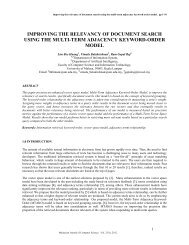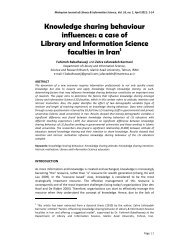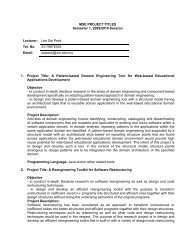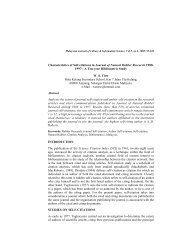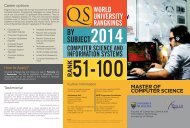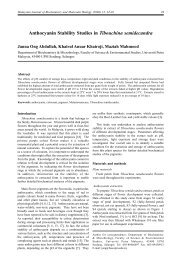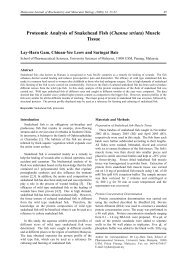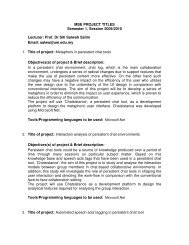Design and Implementation of a Private and Public Key Crypto Processor for Next-Generation IT Security Applications pp. 29 - 45Fig. 16(b): Block diagram of decompression unit4.6 MAP Processor for Wide-Operand Modular ArithmeticThis section presents the design of a Modular Arithmetic Processor (MAP) for the computation, in hardware, of thearithmetic operations defined over a Galois Field GF(P). This processor is designed as a complementary core toenhance the overall timing performance of ECDSA subsystem. The wide-operand (or large integer) modulararithmetic operations were originally performed in embedded software, but its performance is inadequate for ourpurpose as it suffers from a very long computation time. The underlying modular arithmetic operation of ECDSAscheme requires modular multiplication, division/inversion and addition/reduction. Among these operations, themodular division is the most computation-intensive underlying operation in ECDSA scheme. Besides, division is byfar the most costly operation in terms of speed and the speed of the overall processor will depend on a high-speeddivider. Therefore, special attention is given to the computation of the modular division, and is now elaborated.The modular division (y = a/b mod M) is then integrated with other operations, namely modular multiplication (y =a*b mod M) and modular addition (y = a+b mod M) into a complete modular arithmetic unit. This processor is alsoable to perform modular inversion (y = 1/b mod M) by letting a=1 and using modular division instruction. Byletting a=0 in modular addition operation, it can implement modular reduction (y = a mod M). All of the otheralgorithms are carefully chosen so they can share the common hardware resources in the modular divider withoutany major modification on the hardware architecture. However, to implement the mentioned operations, it needs tobe somewhat extended.Fig. 17: Hardware architecture of MAP core40Malaysian Journal of Computer Science, Vol. 19(1), 2006
Design and Implementation of a Private and Public Key Crypto Processor for Next-Generation IT Security Applications pp. 29 - 45The proposed modular divider is designed based on a binary add-and shift algorithm to perform modular divisionpresented by S.C Shantz in [18]. This provides an alternative to division by inversion followed by multiplication.This algorithm is chosen because the most critical operation is shifting and addition/subtraction operation onlyinstead of hardware costly operation such as multiplication and exponentiation operation, resulting in simplerhardware architecture. For modular multiplication, we choose an interleaved algorithm [9], where additionalternates with modular subtraction. This algorithm is simple and straightforward, yet quite efficient. Since it usesstandard number representation, it is relatively easy to implement in hardware. Fig. 17 shows the top-levelarchitecture of the MAP core. It consists of MAP_FSM and MAP_DPU. The MAP_FSM works as the control unit toreceive the condition signals from and send the control signals to MAP_DPU unit. The MAP design is describedcompletely in parameterized VHDL code, such that the core is reconfigurable and reusable for different field sizes.For the prototype presented in this work, it is set to perform 163-bit modular arithmetic operation to fit into theimplemented ECDSA scheme.5.0 FPGA <strong>IMPLEMENTATION</strong> & PERFORMANCE EVALUATIONThe design effort of the proposed embedded system involves hardware design, interface design and software development. Hence, it calls forhardware software co-design, in which both hardware and software are designed in tandem to provide overall system functionality. The hardwareblocks are described in VHDL (VHSIC Hardware Description Language) using VHDLmg, a design entry tool developed in-house in UTM [19].Modeling the processor in VHDL facilitates quick prototyping and modification of the target design while considering various possible trade-offsin different implementations of the crypto algorithms with different speed and area characteristics.Each crypto core is synthesized, simulated, place and routing, and timing analyzed using Quartus II EDA softwarefrom Altera. The complete embedded cryptosystem is prototyped in a single Altera Stratix EP1S40F780C5 FPGAchip employing Altera SOPC Builder. Design verification is performed via timing simulations and the completesystem is validated through the functional evaluation tests performed on the demonstration application prototype.These tests verified that all the required security services (data confidentiality, data integrity, non-repudiation andauthentication) are achieved at an approximate speed of 2.2 kbyte /sec. Due to lack of space in this paper, weprovide below only a sample of the design verification of one of key crypto core, and then we present theperformance analysis and results of each processor core developed in this work, in turn. Fig. 18 shows a snapshot ofthe timing simulation output of the modulation exponentiation module in our RSA coprocessor core. The timingdiagram shows the behavior the core at the end of operation, which completes with the reading the 32-bit resultfrom RAM module in the core to Avalon Bus of the main Nios processor. This verifies this design.Fig. 18: Timing simulation of Modular Exponentiation core - at the completion of the operationMalaysian Journal of Computer Science, Vol. 19(1), 200641



